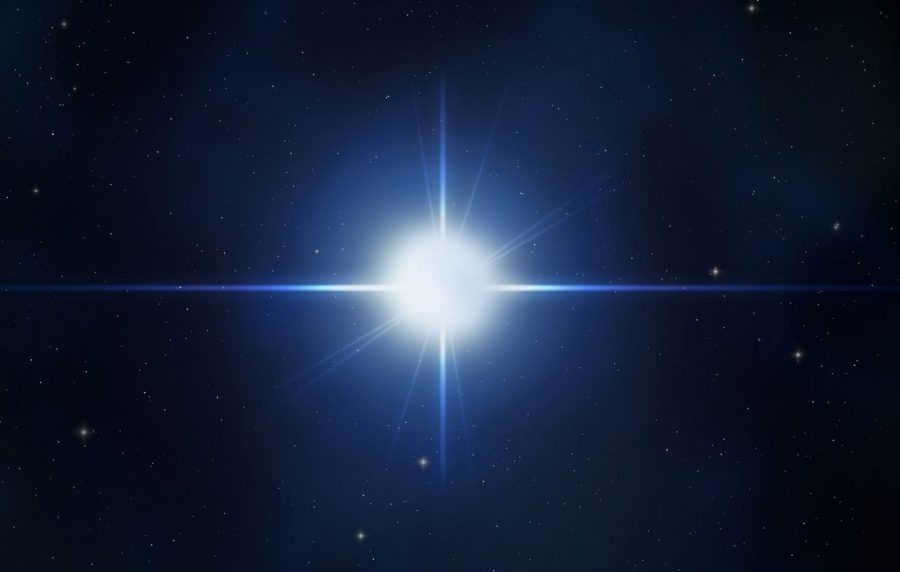
- Stellar Objects
Sirius (α Canis Majoris, Alpha CMa, α CMa) is the most luminous star in the nocturnal sky. It is a binary star comprising of a primary star of spectral type A0 or A1 known as Sirius A and a dim white dwarf of spectral type DA2 referred to as Sirius B. The separation between them ranges from 8.2 to 31.5 astronomical units with an orbital period of 50 years.
Sirius is widely recognized as the α Dog star because it serves as the principal star in the constellation of Canis Major.
The reason why the star Sirius shines so brightly is due to both its own natural brightness and its close proximity to our solar system. With a distance of 2.6 parsecs (8.6 light-years), Sirius stands as one of our nearest neighboring stars. As time passes, this star is slowly moving closer to our solar system, resulting in a slight increase in its brightness over the course of the next 60,000 years. However, after this period, Sirius will begin to move farther away, causing it to gradually become fainter. Nevertheless, for the next 210,000 years, Sirius will continue to hold its position as the most brilliant star in the night sky.
Since ancient times, Sirius has been calling out to people and has remained a favorite among Earthlings.
The more south you go, the clearer the visibility of Sirius becomes. It is undeniable that the ancient civilizations were fascinated by this celestial gem. The Egyptians, in particular, devoted significant attention to this star, even creating a calendar that revolved around the rising of Sirius. The star’s first ascent marked the start of a new year, and a festive celebration was held in its honor.
When the dawn arrived, Sirius vanished and the Nile departed from its banks. This occurrence took place prior to the summer solstice. Following that, the Egyptians’ “leading star” was absent for a duration of 70 days, leading people to believe that during this period, Isis descended into the realm of the dead to reunite with her beloved husband Osiris, who had been slain by Seth, his power-hungry and hateful brother. Isis successfully resurrected her beloved and spent 70 days in his company, causing Sirius to remain unseen.
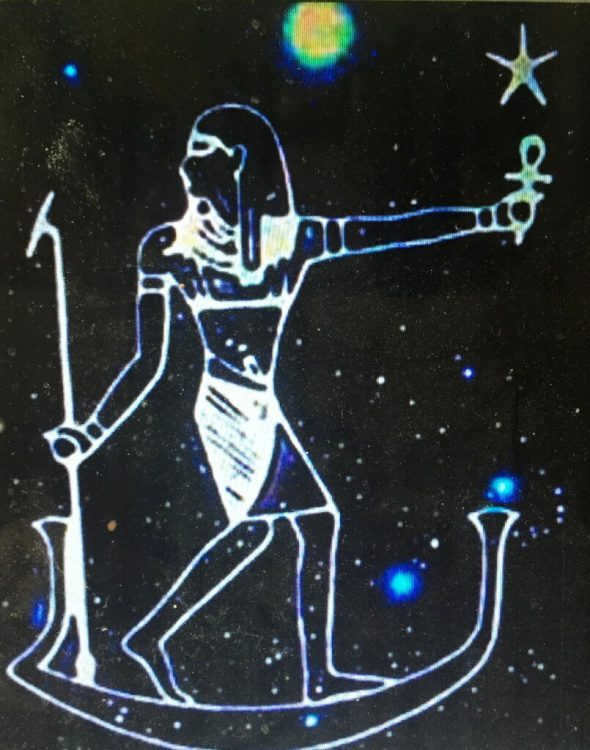
This celestial body appeared to them as a gateway to the realm beyond, and they made an effort to refrain from burying the deceased during the 70-day interval when this celestial body vanished from the skies. Certain individuals hold the belief that the Giza pyramid was constructed in perfect proportion to the positions of Sirius and the three stars comprising Orion’s belt.
Incidentally, the ancient Egyptians possessed a highly precise calendar: they observed that the heliacal rising transpires every Z65.25 days.
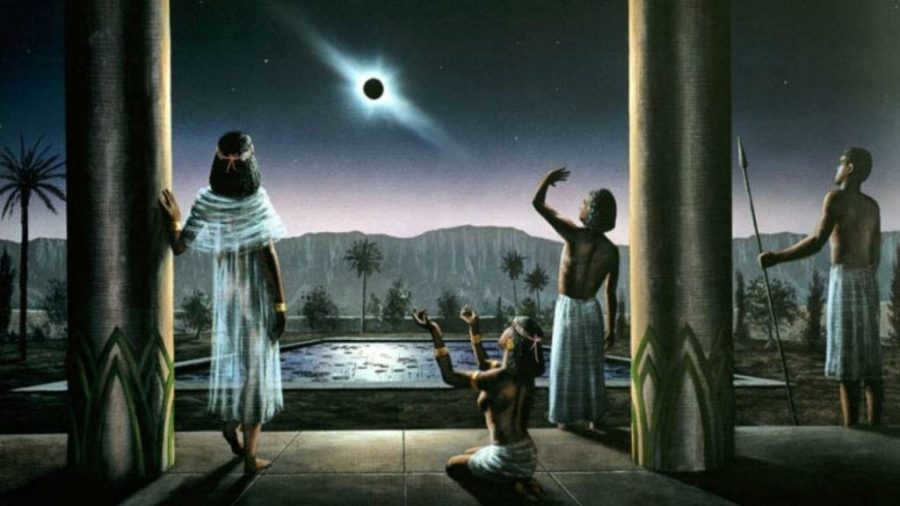
The astute Greeks took note of the star’s arrival coinciding with the onset of a hot season, leading them to dub it as the “burning” star. Sirius was also highly regarded, with festivals held in its honor and close observation carried out. It was believed that a clear visibility of the star symbolized good fortune, while a dim and hazy appearance was seen as a foreboding sign of epidemics, tumultuous times, or wars to come. The Romans shared a similar worldview, performing mass sacrifices of dogs and sheep on the day of Sirius’ ascension.
How amazing is it that Sirius has been called by so many different names! The Chinese referred to it as “the star of the celestial wolf”, while the Polynesians called it the “great bird” and used it as a point of reference. The Hawaiians, however, bestowed the most honorable name upon it – “Queen of Heaven”. Even in the Koran, Sirius was referred to as the “Mighty Star”. In Scandinavia, it was said to be “Loki’s torch”.
But perhaps the most intriguing story comes from the Dogon, a remote people living in the Republic of Mali. They possessed knowledge that could not be seen without telescopes: they claimed that Sirius is actually a binary star with an orbital period of 50 years. What’s more, the tribe had been observing this star for over 5,000 years, and their legends tell of our species evolving from the amphibious race of Nommo, who hailed from Sirius.

According to ancient Dogon legends, the god Nommo traveled from Sirius to their dwellings, bringing along a multitude of diverse animals on his ark-like vessel (a fascinating parallel with the biblical story of Noah’s ark). The origins of humanity can be traced back to Africa. The flight path of the ark was even recorded in the Dogon temples, depicted as a curved line encircling the constelltion of Sirius and the Earth. Could it be possible that we originated from Sirius? And how did the Dogon possess knowledge of Sirius being a binary star system and its orbital period? However, it is important to note that these accounts are merely mythical in nature.
It is interesting to note that the Chinese and Sumerians had different descriptions of Sirius. The Chinese saw it as a red-colored star, while other peoples perceived it as radiant white. This discrepancy led to the creation of various mythical stories, similar to those seen on RenTV. However, the explanation for this difference is quite simple – a passing interstellar cloud could have temporarily altered the color of the star.
What exactly is Sirius?
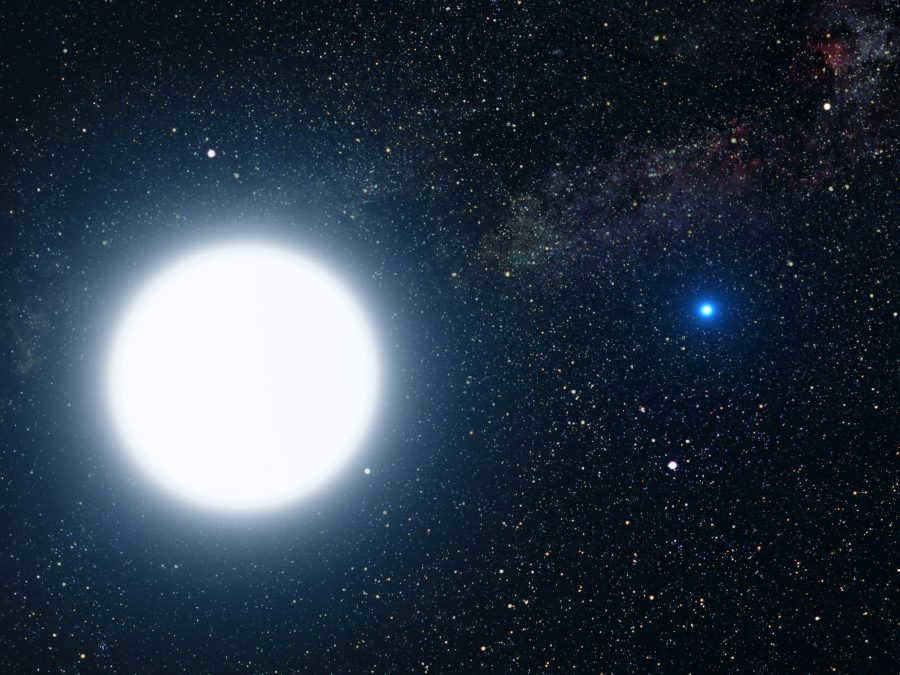
Fairy tales may be just fairy tales, but the Dogon tribe seems to have been onto something. While we perceive Sirius as a lone star in the sky, it is in fact a binary star system comprising of Sirius A, a star of spectral class A1, and Sirius B, a white dwarf. These two stars revolve around a shared center of mass, completing a full orbit every 50 years. The average separation between them is approximately 20 astronomical units (a.u.), similar to the distance between the Sun and Uranus. This remarkable celestial formation is estimated to be around 250 million years old.
From Earth, the first star that is visible is Sirius A. In terms of mass, it is approximately twice the weight of the Sun and is 25 times brighter. Additionally, the radius of Sirius exceeds that of the Sun by 71%. The surface temperature of Sirius A is around 9,666 C, whereas the Sun’s temperature is 6,000 C. Currently, Sirius A is expected to last for another 660 million years before transforming into a red giant and eventually a white dwarf.
Sirius B is the second component of the star system and happens to be the very first white dwarf ever discovered. In 1844, Friedrich Wilhelm Bessel, a German astronomer and mathematician, observed that the trajectory of Sirius A occasionally deviates from a straight path. Bessel postulated that another massive object, rotating around a common center of mass with Sirius A, was influencing the star’s trajectory. However, Bessley’s theory was largely ignored because the mass of this hidden object was estimated to be equivalent to our Sun! However, in 1862, American astronomer Alvan Clark confirmed Bessel’s hypothesis when he spotted a small star near Sirius through his new telescope. This “star” was found to have an orbital rotation that matched Friedrich Bessel’s calculations, and it was subsequently named Sirius B.
Sirius B, currently the heaviest known white dwarf, is comparable in mass to the Sun but similar in size to the Earth. Originally a main-sequence star, it underwent the red giant phase before “dying” and transforming into its current state. This transformation occurred approximately 120 million years ago. At one point, Sirius B was five times more massive than the Sun. Now, it has a very faint luminosity, only 0.026 times that of the Sun. The star’s future fate involves gradually cooling down, fading out, and further cooling.
There have been no discoveries of inhabitable planets in the double system of Sirius. Additionally, there are several factors that indicate the unlikelihood of finding any. Firstly, the star system is too young for the development of life. Secondly, any planets that may have existed in the habitable zone were destroyed when Sirius B transformed into a red giant.
Star’s whereabouts
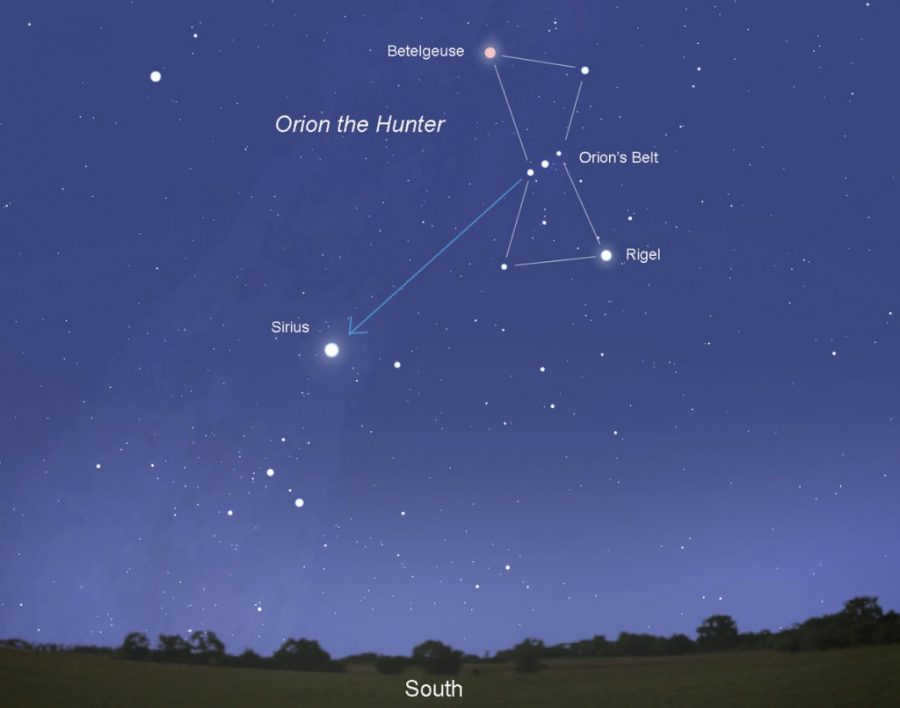
Sirius can be observed from any location south of 7Z°N. However, when moving further north, it appears lower on the horizon. Sirius is considered circumpolar, meaning it remains above the horizon at all times.
Due to precession, the star Alpha in the constellation Big Dog will shift towards the south. By the year 9000, it will not be visible from most areas in north-central Europe. In 14000, the polar star will be Vega.
To locate Sirius, you can use the stars Alnilam, Alnitak, and Mintaka, which form Orion’s belt. For observers in northern latitudes, Sirius can be seen in the southeastern, southern, and southwestern sky during the winter. In late summer, it can be found in the eastern sky before dawn.
- Sirius is the brightest star in the Big Dog constellation.
- Constellation: Big Dog.
- Distance from Earth: 8.6 light-years.
- Orbital period: 50.090 years.
Names: Sirius, Dog Star, α of the Canis Major, 9 Canis Majoris, HD 48915, HR 2491, BD -16° 1591, GCTP 1577.00 A/B, GJ 244 A/B, LHS 219, ADS 542Z, LTT 26Z8, HIP Z2Z49, B:EGGR 49, WD 0642-166.
Physical characteristics and orbit
Sirius A
- Spectral class: A1V.
- Visible magnitude: -1.47.
- Absolute magnitude: 1.42.
- Mass: 2.02 times that of the Sun.
- Radius: 1.711 times that of the Sun.
- Luminosity: 25.4 times that of the Sun.
- Temperature: 9940 K.
- Age: 2Z million years.
- Spectral class: DA2.
- Visible magnitude: 8.Z0.
- Absolute magnitude: 11.18.
- Mass: 0.978 times that of the Sun.
- Radius: 0.0084 times that of the Sun.
- Luminosity is measured at 0.026 solar units.
- The temperature is recorded at 25200 K.
The Enigma of Sirius
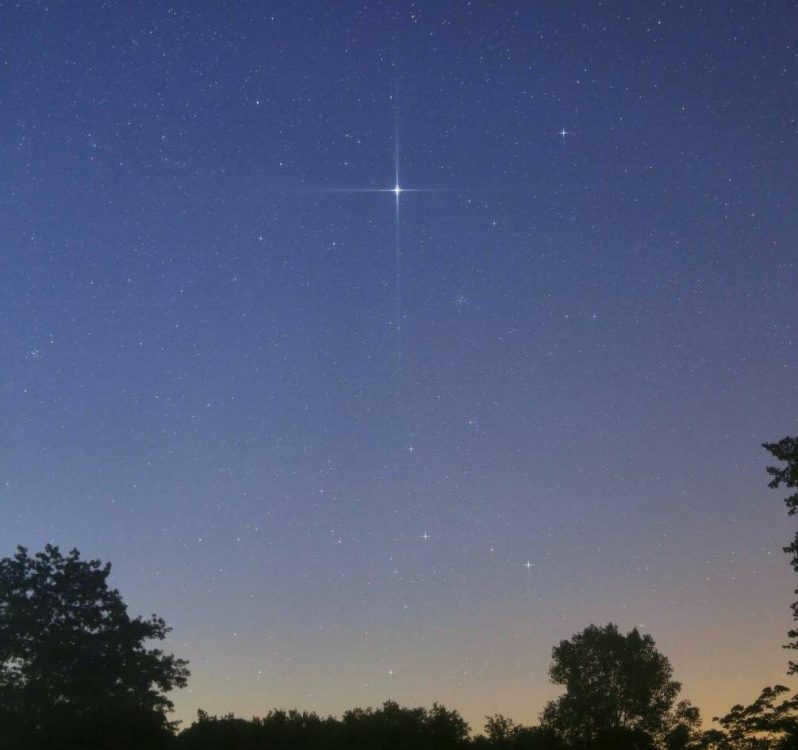
The color change of Sirius remains a perplexing enigma. According to ancient astronomers, this celestial body was said to emit a red glow.
This transformation is a common occurrence, but the shift from a red giant to a white dwarf typically takes millions of years and leaves behind a noticeable gas cloud. In contrast, Sirius underwent a color change within a mere 2,000 years.
Modern scientists have proposed several theories to explain this phenomenon:
- One theory suggests that the descriptions of ancient astronomers may have been metaphorical or subject to translation errors. In ancient times, red was often associated with negative omens, so it is possible that this object was perceived as ominous when it appeared on the morning horizon.
- Due to volcanic activity, it is possible that the Earth’s atmosphere was filled with dust, resulting in Sirius appearing red.
- There is a theory suggesting that 2,000 years ago, the red giant (B) had not yet undergone its death and transformation into a second white dwarf. However, this hypothesis does not align with the timeline, as there would have been a long-lasting cloud afterwards that would have persisted for tens of thousands of years.
- Some scientists speculate that there may be a third star, C, in the system, with a revolution period of 2,000 years around the center of mass. However, there is currently no confirmation of this.
- Another hypothesis suggests that there could have been a dust cloud between Sirius and the solar system in the past, which could explain the red hue observed.
Modern astronomers have not yet been able to confirm either hypothesis, leaving them without a conventional explanation for the color change.
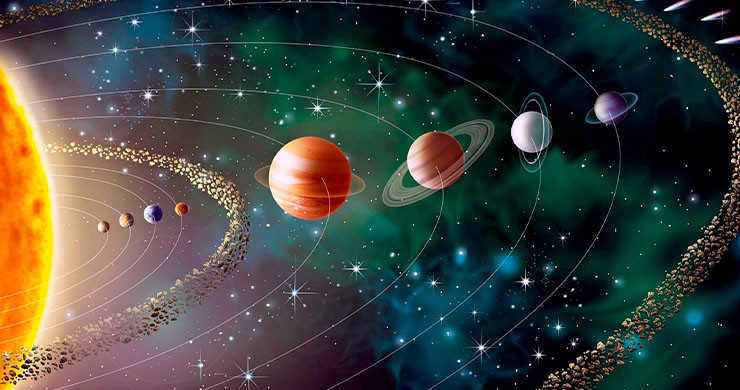
What information do we have about the star Sirius?
- The star Sirius is the brightest star in the constellation of the Big Dog. It is also the brightest star in the night sky because of its close proximity to Earth. Sirius is one of the closest stars to our solar system, located only 8.6 light-years away.
- In 1862, astronomers discovered that Sirius is a binary star system. It consists of two stars, Sirius A and Sirius B, which orbit around a shared center of mass.
- The name “Sirius” comes from the Greek word for “bright” or “brilliant”.
That’s the extent of our knowledge about this particular star.
In the field of Hissidiology, the star Sirius is known by the unique Cosmic Code SSAALLIIIIIRISS and possesses a distinct frequency that aligns with the creative vibrations emitted by our Sun star (AIIIIIIIIISS).
1.1771. The SSAALLIYRISS Star System comprises of 18 primary Planetary Entities, along with 97 accompanying FUIFFO-RSTMs (referred to as “Planetoids”) that vary in their developmental levels. These entities functionally provide the necessary conditions for the successful collective realization of Cosmic Creations initiated by the main Planetary Creators. Additionally, there are 68 GAACCRs, which are artificial satellite planets designed to fulfill the goals and objectives of planetary civilizations.
1.1772. The dense-material Globes of the Planets, along with their planetoids and satellite planets (if present), are strategically arranged around the Star in the following sequential order:
The mechanisms of Formo-Plasma and Formo-Matter formation on our planet Earth (GREISSLISS) bear many similarities to the fundamental processes involved in the synthesis of Astro-Plasma and Mento-Plasma within the Sirius star system, albeit with slight variations in the primary vector directions of these synthetic processes. An intriguing exploration awaits us as we delve into the examination of these processes across multiple planets within this stellar system.
The 8th planet “EIRSGLLAISS.”
“1.1774. The physical Globe of the Planetary Entity EIRSGLLAISS, which serves as a spiritual “Pramatera” for GRAIISLIISS, occupies the eighth orbit (counting from the Physical Globe of SSAALLIISLIISS). It rotates along this orbit together with 4 of its FUYFFOO-RSTM and 8 dense-material artificial GAACCR, which were specifically created by the Planetary Creators to ensure the stability of some of the most important systems of physical life support.”
Within the Sirius star planetary system, there is active parallel adaptation of numerous HIE-Forms to the specific conditions of the lower realities of Earth. This adaptation is necessary due to the significant differences in the properties of Energy-Plasma layers that have the same vibration level but belong to different Cosmic Flows and Vectors.
Thus, for instance, in the cosmic realities of the eighth planet EIRSGLLAISS, all conditions have been established for the successive “inhabitation” of different Celestial Beings in the highly distinctive frequencies of LLUU-VVU-Forms of “humanoids”, “Stablosans”, “Lovirgidians”, as well as “Graysians”, “Trifftians” and “Zeidztians”. It is precisely these civilizations that serve as the foundation of our self-awareness on the aossoon levels 1-4 AIGLILLIAA (2.5-4.5 dimensions).
The organization of the physical realities on the planet EIRSGLILLAISS is managed by the Collective Consciousnesses of over 120 planetary civilizations, many of which have achieved a higher level of development compared to our Earth civilization. It is important to highlight that we maintain constant telepathic and psychic connections, even across vast cosmic distances.
9th planet “OLGRRIIRGSS”
The primary component, which forms the physical foundation of the numerous realities on the ninth planet OLGRRIIRGSS, can be relatively likened to our water in certain astral-physical characteristics. As a result, within the realms of this planet, the highly advanced Form Creators from the extraterrestrial civilization AIULLGV educate the Planetary Creators on how to adapt both astrally and physically to the SSU-VVU-Forms (“dolphins”, “sharks”, “coccaidra”, and “stirluros”), OOGL-HLHV-Forms (“whales”, “prurts”, and “voyturks”), UURT-HLHV-Forms (“stingrays”, “sprouts”, “alakkarudas”, and “swyurs”), and PRIIR-HLHV-Forms (“octopuses”, “cuttlefish”, “squid”, “vodullas”, and “rakkarurds”).
The 17th planet “SBAALL-GAAR-TILLSS.”
“1.1800. SSLOO-SS-SNAA-Creators of Forms from the civilization LLAAAUI-YSS have chosen the seventeenth Planet – SBAALL-GAAR-TILLSS, where the mental-astral adaptation of the Cosm. Entities to the Forms of Mind that you refer to as “Animal Kingdom”, “Collective Animal Souls”, etc., but who in many other types of astral reality GRIEFSLYISS have the same privilege to develop as you do in your physical subtype of reality.”
1.1801. The Physical Globe of this Planetary Entity operates without artificial satellites or planetoids, as its primary focus is on the intricate processes of desloifiltration and depolarization of numerous local systems that synthesize twelve-dimensional Astro-Plasma flows with identical Mento-Plasma flows of the same quality. This necessitates precise and coordinated work from all components of this transmutation system.
Approximately 300 planetary civilizations actively engage in astral-mental creativity on this planet. They maintain ongoing psychic and telepathic communication with analogous Forms of Mind on Earth, Jupiter, Saturn, Venus, and other Star Systems.
3rd Planet “BUAFFTMM.”
The planetary system of BUAFFTMM’s third planet does not specifically consist of Planetoids, but instead features 8 satellite planets that have been artificially created. These satellite planets serve as a hub for the highly advanced civilization known as the HATORS, who reside on Venus and are dedicated to perfecting and modifying various Astro-Forms.
“1.1804. The synthesis of your Astro-Forms (as well as VVU-Forms) relies on diverse ranges of Energy-Plasma, commonly referred to as ‘photons’ or ‘quanta of light’. However, the foundation of the Hators’ most dynamic Astro-Forms is a unique etheric Matter, formed from various ‘sound’ frequencies or a refined fusion of different waves from other Energy-Plasma ranges. These ranges can be loosely associated with conventional concepts of ‘light’ and ‘sound’.”
The Hathors are an extremely organized civilization on Venus, but they are not the only highly intelligent beings there. There are other highly intelligent civilizations as well, including the Rroorrds, Goaaians, Sississians, and Tuurduuttas, who have a different form than the humanoid Hathors. The humanoid Hathors have a unique combination of high Knowledge and high Feeling, while the non-humanoid civilizations have a certain etheric-astral Form.
There are hundreds of other Venusian civilizations that do not have physical forms like the Hathors. Instead, they exist in the realms of Sound, Thought, and Sense waves. Some of these civilizations have stable spherical lettuce and emerald, blue, amethyst, and violet “ultralight” Forms.
1. In 1812, there are also fifty-three specific realities of various kinds (such as “sensory-sound,” “thought-sensory-sound,” “mental-sound”), where intricate processes of mutation and transformation through creative synthesis are conducted to attain the most advanced Forms of Mind, possessing the most vibrant and boundless potential for self-expression within the given scope of Cosmic Energy-Plasma Creation encompassing different Rays and Aspects of each of the 12 Reference Qualities.
The explanation of the functionality of other planets in the Sirius system does not hold significant relevance for us, as it is not directly connected to our earthly existence.
Finally, I would like to draw attention to the fact that our future evolution in the 6-9 dimensions takes place not on Earth, but specifically on Venus, where our VEN-unpacking is completely transformed into PES-dynamics, enabling us to achieve the state of “Creative Cosmic COMPLETION”.
2021-10-21 at 10:53, admin Astronomy, stars, cosmos, constellations.
Near, luminous, rapid
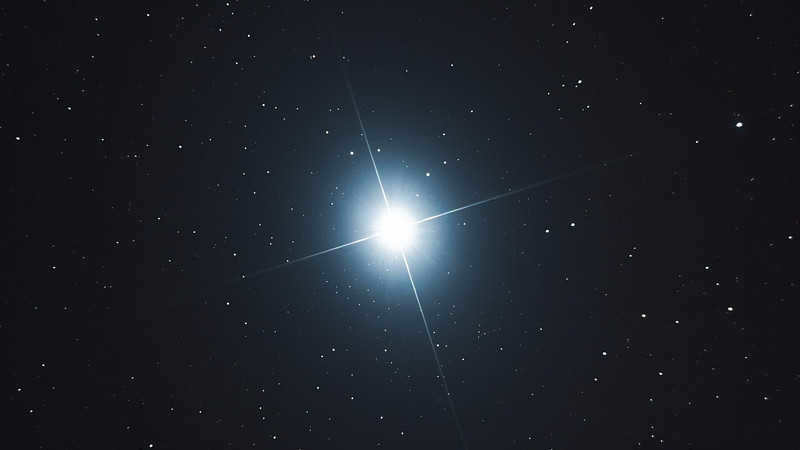
Not everyone is aware of the brightest star in the sky. If you were to ask a random person on the street, “Which star is the brightest?” not everyone would answer Sirius. Many people mistakenly believe that it is Polaris. However, an informed respondent would mention the Sun, which is partially correct, although we usually refer to the numerous stars visible at night.
Sirius, also known as the alpha star of the Canis Major constellation, holds the title of the brightest star in the entire sky. Its apparent magnitude is -1.5m, making it the only star with a luminosity beyond minus one. In terms of brightness, Sirius stands out significantly from other stars. Its closest competitor, Canopus (alpha Carinae), is nearly twice as faint and cannot be seen from Russia.
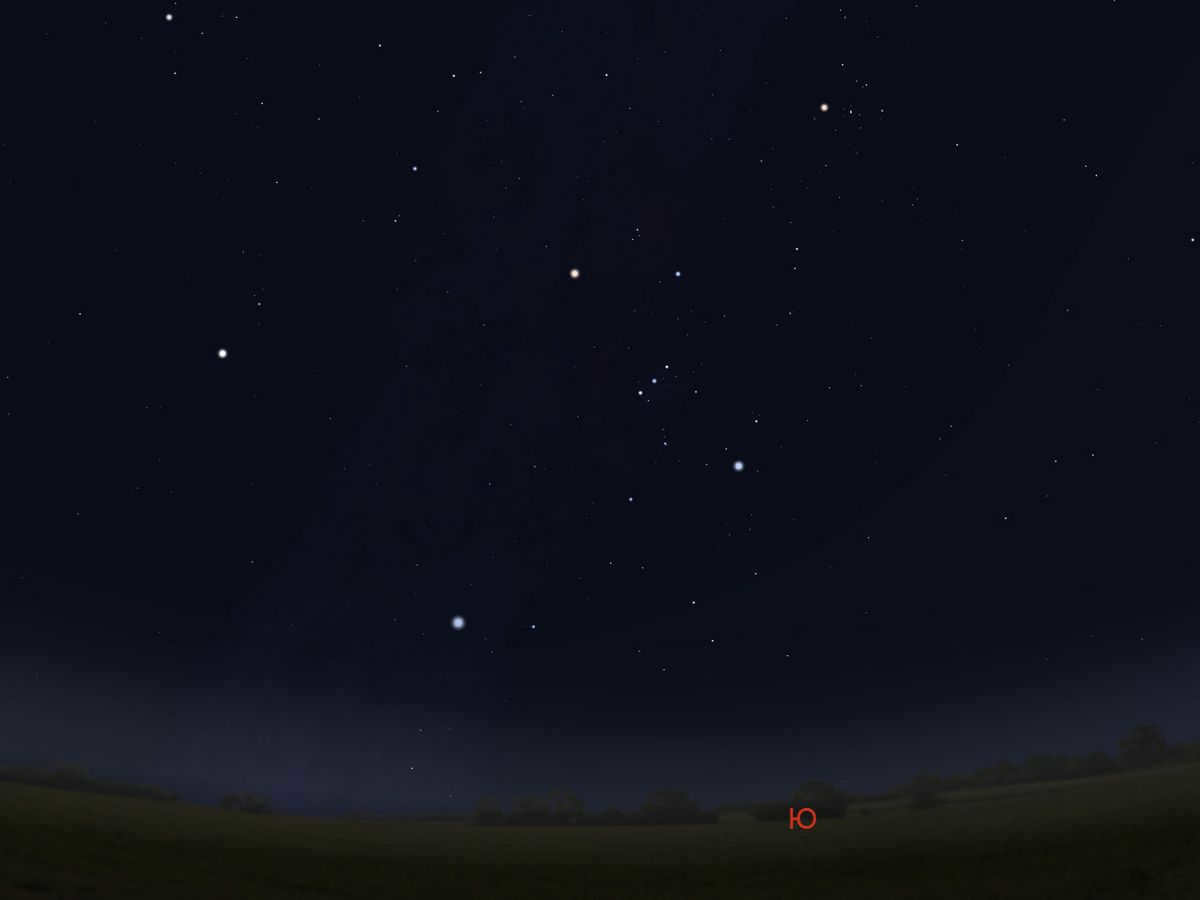
Sirius can be seen in the night sky from autumn to spring. The winter season offers the best opportunity to observe this star. It is situated in a region of the celestial sphere filled with numerous brilliant stars, but it is positioned below all of them. Consequently, Sirius might not appear as the brightest star due to the significant light absorption in the atmosphere near the horizon. The presence of haze, fog, and clouds that move along the horizon can cause Sirius to lose some of its luminosity.
However, its beauty remains intact. Glittering and sparkling in the cold winter air, it truly resembles a diamond. Sirius is a star of a white hue, but due to the bending of its light rays in the atmosphere, it may take on a blue hue, similar to its “neighbors” from the constellation of Orion. By the way, Orion is an excellent guide for locating Sirius and ensuring you find what you seek. The three stars that make up Orion’s belt will direct you towards Sirius. Simply extend the line connecting these stars towards the horizon.
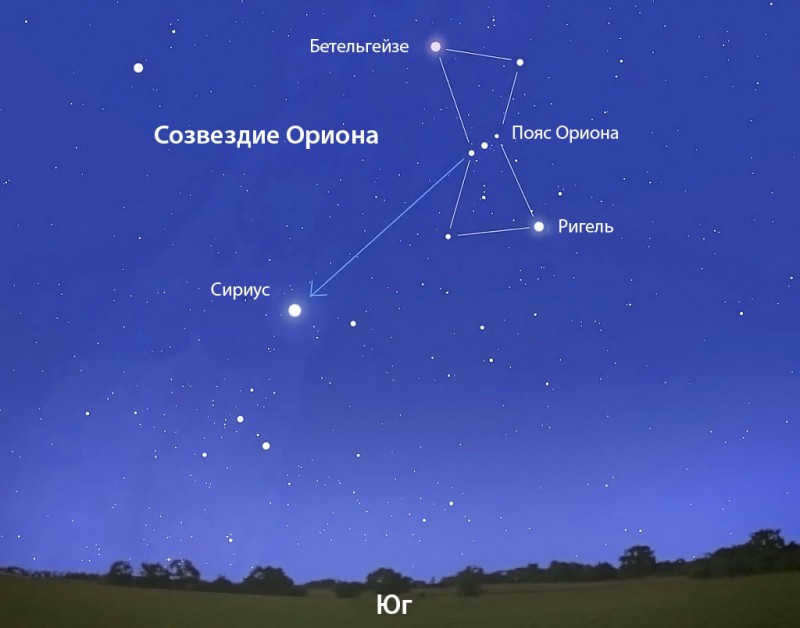
Throughout history, Sirius has held great significance in human civilization. Its importance was particularly pronounced in ancient Egypt, where its first predawn appearance marked the beginning of the Nile’s annual flooding and the start of the new year in the Egyptian calendar. Sirius was also closely associated with multiple deities and often depicted alongside them.
In Greek mythology, Sirius was linked to one of the hunting dogs of the celestial hunter Orion. The Greeks recognized Sirius as the most brilliant star in the sky, leading them to refer to it as “The Brightest” – a translation of its name from ancient Greek.
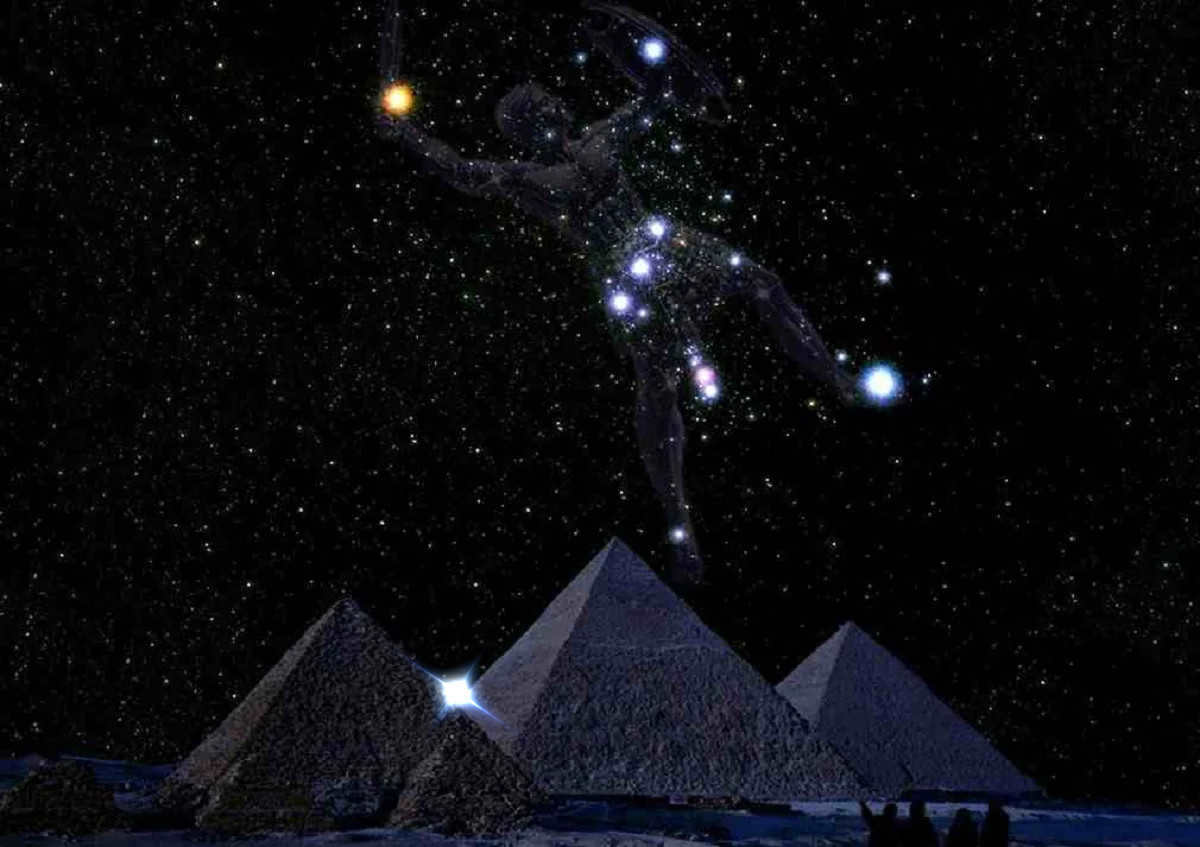
However, the Romans adopted another name from the Greeks – “Dog Star” or “Puppy” – which in Latin was pronounced as “Vacation”. In ancient Italy, the rising of Sirius before dawn coincided with the peak of heat, and during this time almost all activities came to a halt – the Romans referred to this period as “Vacation”. Interestingly, even today, a break from work or study is referred to by the same name.
For unknown reasons, ancient chronicles from Egypt, Babylon, and China mention Sirius as a red luminary. This was long attributed to translation errors, but now there is a different interpretation. However, we will discuss this later.
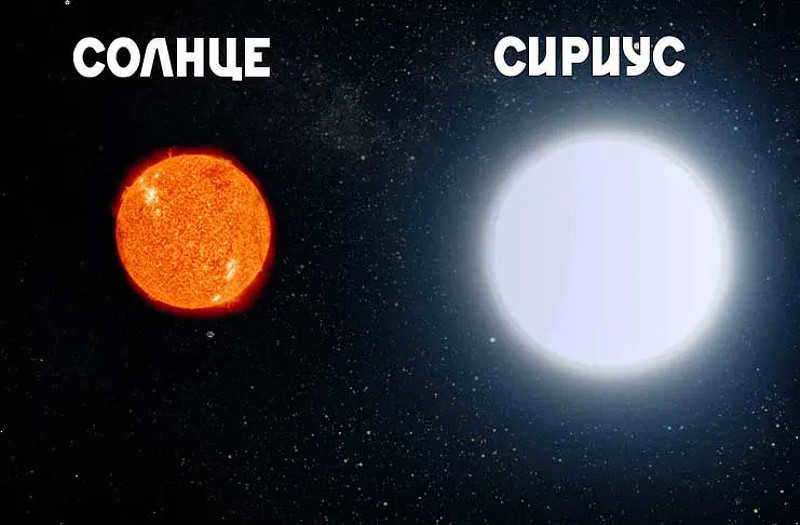
Sirius has a luminosity that is 25 times greater than the Sun’s
Astronomers define luminosity as the relative brightness of stars when they are located at the same distance from the observer. They compare it to the brightness of the Sun under the same conditions. If the Sun were as far away as Sirius, it would appear 25 times dimmer – resembling a second magnitude star, like the nearby beta of the Big Dog. However, it’s important to note that the beta of the Big Dog, known as “Mirzam,” is actually located significantly farther away than Sirius.
The reason why Sirius appears to be so bright is because it is one of the stars that is closest to us. In fact, Sirius is the 7th closest star to the Sun. The only stars that are closer than Sirius are the Alpha Centauri system and a few dwarf stars that cannot be seen with the naked eye.
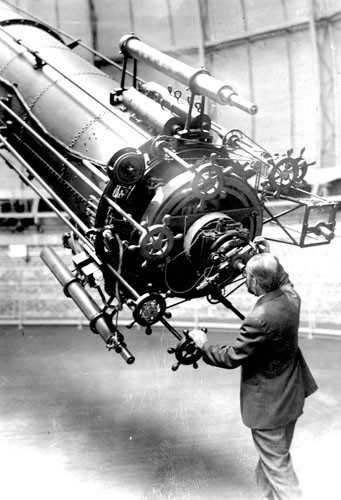
Sirius was historically thought to be a solitary star until Alvan Clarke, a renowned optician and astronomer, pointed his powerful new telescope refractor at Sirius over a hundred and fifty years ago. This revolutionary observation led to the discovery of Sirius B, the first ever supercompact object.
This newfound star turned out to be a white dwarf, a retired star among the celestial bodies. Prior to Clarke’s discovery, white dwarfs were purely theoretical. The theory of stellar evolution had long predicted that stars like the Sun, with comparable masses, would eventually reach a phase known as the final stage, similar to that of a white dwarf. However, no such object had ever been observed until Sirius B.
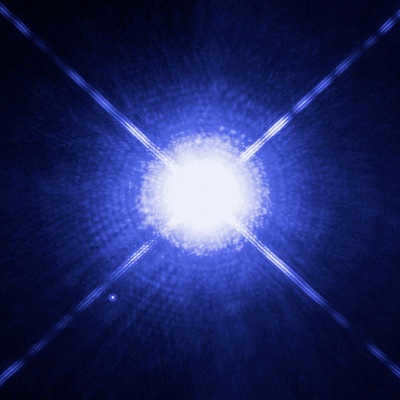
There is a possibility that it has swelled to the size of the red giant Sirius B and was determined in ancient Egypt and Babylon to have the overall color of the entire system.
Sirius is known to be one of the fastest stars in our sky. We are currently discussing the visible movement of this celestial body. Interestingly, the movement of Sirius was observed before that of most other stars – this star shifts across the celestial sphere by approximately one and a half angular seconds per year. Since Hipparchus first measured the positions of stars, Sirius has traveled a greater distance than the diameter of the moon.
Furthermore, Sirius, despite not being particularly swift compared to other stars, is progressively drawing nearer to the Sun – the distance between us is decreasing by 5 kilometers every second. This implies that Sirius is becoming more and more luminous. I am uncertain if, within a human lifespan, the increase in its brightness will become perceptible. On the contrary, the celestial bodies in our terrestrial sky will only fade as the atmosphere warms up and becomes contaminated. However, in the foreseeable future, some of us will relocate to Mars, where they will have the opportunity to continue fully appreciating the radiance of the stars, among which Sirius will remain the most brilliant for an extended period of time.
However, it will face tougher competition
When observed from the Earth, Sirius appears to be the brightest among the stars (excluding the Sun). Nevertheless, there are numerous planets that outshine it. Venus, Mars, and Jupiter, for instance, often appear significantly brighter than Sirius. If we were to travel to Mars, we would no longer see the red celestial body in the sky (since we would be standing on it!), but we would be able to spot Earth among the other luminous star-like objects – it would be much brighter than Sirius. Additionally, we would also be able to see Phobos and Deimos – the satellites of Mars, which would appear as exceptionally bright stars from the planet’s surface.
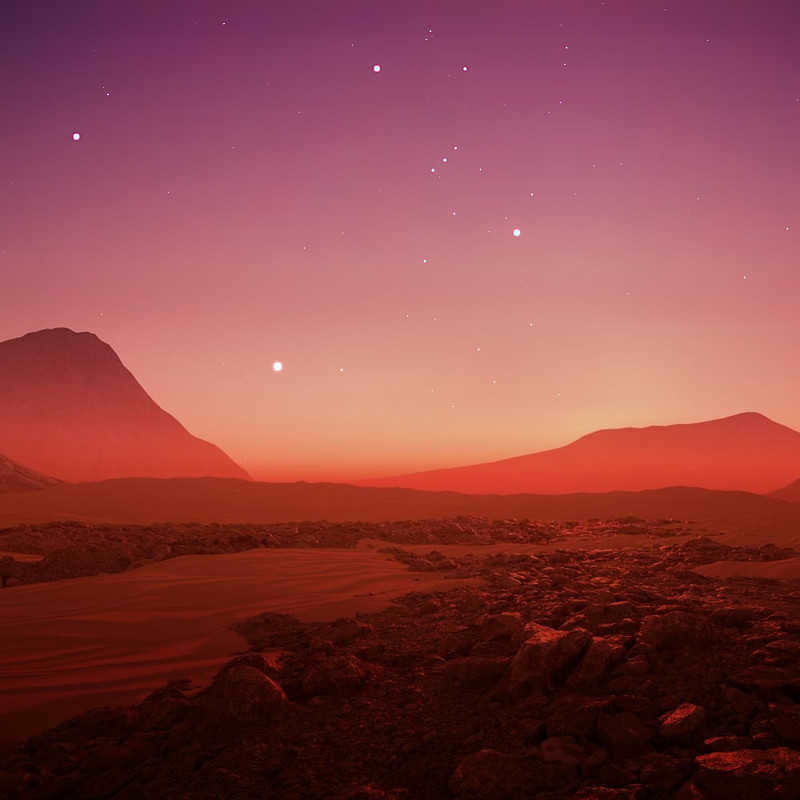
However, the arrangement of stars in the constellations will not be affected by the journey to Mars – their shapes will remain unchanged. Even from Mars, Sirius will still be the brightest star in the Canis Major constellation, and it can be easily located by extending Orion’s belt in the southeastern direction.
As a bonus for those who have read this far, I would like to share a musical piece called “The Lonely Sphinx.” This composition is inspired by the ancient architectural artifact that has been observing Sirius in the night sky above the pyramids for thousands of years. “The Lonely Sphinx” is the opening track of my 2006 album “Life or Love.”
Sirius! You may not be aware of the exact location of this splendid star, but chances are you have caught sight of it on multiple occasions. It can be found within the constellation Canis Major, colloquially known as the Big Dog, and rightfully holds the esteemed position of being the Alpha of the Big Dog. In the celestial sphere, Sirius stands out as the brightest luminary during the nighttime hours, a fact that comes as no surprise. Despite the vast distance of 8.6 light years that separates us from Sirius, this celestial body radiates a staggering 25 times more luminosity than our very own Sun.
What made ancient astronomers refer to Sirius as the red star?
Let’s now attempt to answer the question – what is the color of Sirius? It is widely accepted that the color of this luminous star is white or even bluish. However, it is interesting to explore the perspectives of ancient astronomers on this matter.
- “during the days of cold, frost, and ice, when the Arrow star appears, it shines with a fiery red hue resembling copper.” (Akkadian kingdom, 11th century B.C.)
- “the sky reveals a variety of colors: the Dog star is bright red, Mars appears dimmer, Jupiter lacks any color and emits pure light.” (Seneca, 2nd century B.C.)
- “the Dog star, situated at the mouth, is the reddest and brightest among the stars.” (Claudius Ptolemy, 1st century B.C.)
Other testimonies exist, too. To summarize, all ancient astronomers concur on one point – Sirius is not white, but rather a red star, or perhaps flickering, meaning its color changes.
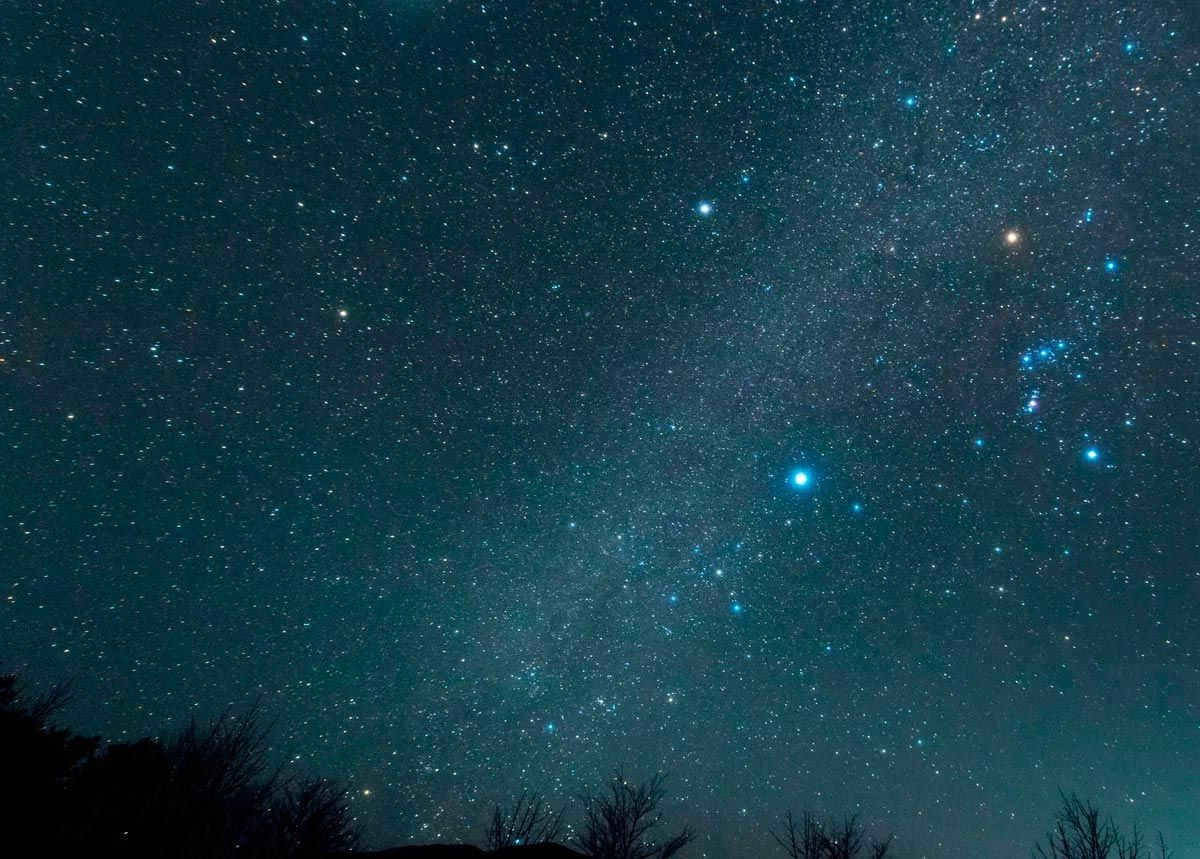
This celestial image has likely witnessed everything. The vibrant crimson star located on the right side is Betelgeuse, positioned on the same line to its left is Procyon, and the most luminous star beneath the other two is the splendid Sirius. However, it is indeed not red in color.
Schallerup hypothesized that the reason for the significant discrepancy between renowned astronomers from the 2nd and 10th centuries can be attributed to an error made by the scribe of the Almagest. It is believed that the scribe misunderstood the term “Sirius” and replaced it with “fiery red,” despite the fact that Ptolemy actually compared Sirius to Mars rather than to red stars like Betelgeuse or Antares.
It is possible that Al-Sufi had access to a different copy of the Almagest that did not contain this mistake. Alternatively, it is also plausible that Ptolemy’s authority among medieval Arab scholars was so highly regarded that Al-Sufi, even though he recognized the disagreement, chose not to openly challenge it and remained silent on the matter. Thus, the enigma of the red Sirius came into existence.
An astronomical “civil war” – the battle between red Sirius and white Sirius.
So, in the early days of recorded history, reputable scientists classified Sirius as a red star. However, by the 10th century AD, no one referred to Sirius as red anymore. What caused this change?
According to our current understanding of stellar evolution, we know that the companion of the current white dwarf Sirius A, known as Sirius B, was once a red giant. Could this have been the red star observed by ancient astronomers? However, there is an apparent discrepancy: one millennium is not enough time for a star to transform from a red giant into a white dwarf!
Nevertheless, in the late 1800s, there was a strong opposition to Schallerup’s explanation by the renowned American astronomer Thomas Jefferson Jackson C.. In contrast, the eminent astronomer and astrology expert, Giovanni Schiaparelli, who discovered the canals on Mars, argued that Sirius appeared identical in the past as it does in the present day.
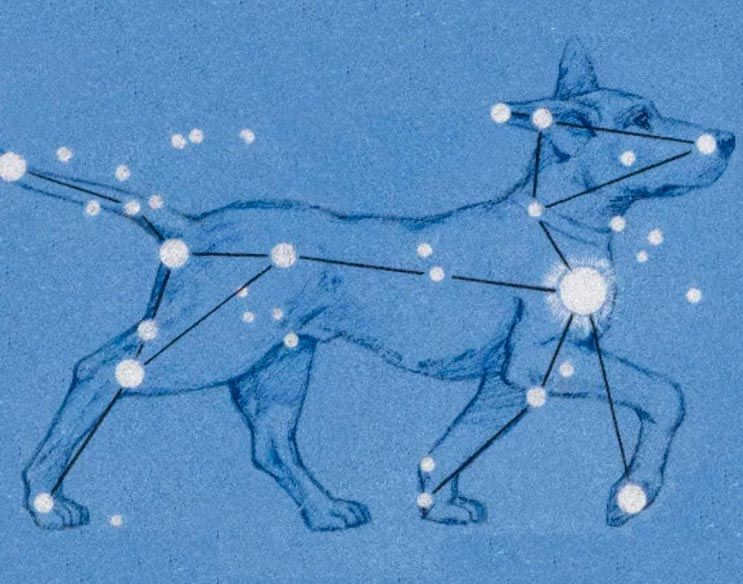

Due to the lack of a universally recognized representation of constellations, it is not uncommon for Sirius to be depicted in the chest rather than the mouth of the Big Dog figure.
Other astronomers got involved in the dispute. Scheiner from the Potsdam Observatory claimed that changing the color of Sirius from red to white was impossible. On the other hand, Vogel, the director of the same observatory and a spectroscopist, diplomatically argued that “anything is possible in the heavens.” The most esteemed astronomer of the late 19th century, Simon Newcome, supported Schiaparelli’s viewpoint in his renowned book Stars. In 1918, Viennese Prof. Johannes Holecek further expanded on Schiaparelli’s argument.
Despite its small size (comparable to the Earth), this celestial object possesses the mass of the Sun, resulting in an exceptionally high density. Additionally, its surface temperature matches that of its host star, Sirius A. This particular white dwarf holds the distinction of being the first one ever discovered.
In 1927, an influential publication called “Aztgopoggyespe Masnsytep” featured a groundbreaking study by American scientist Thomas Sy. Within this work, Sy thoroughly examines the question of Sirius, approaching it from the same perspective as in the 1890s. However, he delves even deeper and presents a more compelling argument, suggesting that Sirius was red during the time of Ptolemy.
No less confidently expresses the same opinion five years later, the renowned Swedish astrophysicist Knut Emil Lundmark. He bases his argument primarily on astronomical considerations. The notion of a star evolving from red to white does not concern him in the slightest. Lundmark is well aware that Sirius is an extraordinary star. There is already a wealth of information regarding changes in the physical state of stars, both explosively and conservatively. It has been established that a star can undergo significant changes in luminosity over the course of a century, as observed in this particular Kiel star. However, the mechanisms behind such changes are only beginning to be understood in the mid-20th century. For now, let us briefly delve into antiquity.
Is it possible that the ancients were mistaken about the color of Sirius or simply confused it with another star?
There is no way to be completely certain, so it would be unfair to accuse our ancestors of ignorance or inattentiveness. It is highly unlikely that they could have confused the “Alpha” of the Big Dog constellation with any other star, considering that Sirius, as the brightest star in the sky, held significant importance in the ideology and rituals of ancient Greece, Egypt, and Rome.
The Egyptians, for many centuries, were the first to observe the heliacal rising of Sirius in the morning sky, which indicated the beginning of the Nile flooding. They believed that Sirius was the tear of Isis, known as Sothis, and that when it fell, it caused the river to overflow. In Greece and Rome, however, the appearance of Sirius in the sky was associated with the start of a scorching heat wave.
Ancient astronomers placed Sirius in the constellation Canis Major, which translates to “big dog” in Latin. This is why they referred to it as the “dog star”. In the northern regions, we experience extremely cold temperatures during the winter when Sirius dominates the starry sky. It is clear that Sirius captivated the attention of philosophers, astrologers, and ordinary people alike.
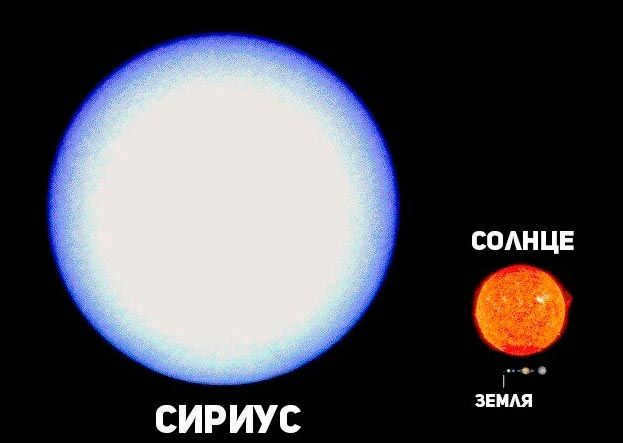
A comparison of the size between Sirius A and our Sun
The name Sirius originates from Greek roots. However, it is infrequently utilized, with the Dog being the more common term used to refer to this star, as it represents the primary star in the entire constellation. Many writers, starting from Homer and continuing through Roman authors of the 2nd century AD, refer to Sirius as the Dog. During this same time period, Ptolemy also avoids using the name Sirius, but instead mentions the brightest star in the mouth of the Dog, which he describes as the “dog star and red.” Numerous writers also refer to it as red.
Meanwhile, to satisfy the celestial Canine during the holiday season, the ancient Greeks in the 3rd century BC performed a ritual sacrifice of a crimson canine. This tradition later spread to Rome and thrived during the reign of Antonimos in the 2nd century AD.
Arguably the most compelling endorsement of Ptolemy’s assertion regarding the hue of Sirius is Seneca’s remark, made a century prior to Ptolemy’s statement and previously mentioned: “The Doge shines with a bright crimson hue, Mars appears dimmer, and Jupiter lacks any discernible color, emitting only pure light.”
According to our research, there are indications that Sirius may have been red in the early 1st millennium A.D. and then transformed into a white star by around 980 A.D. The exact timing of this change remains uncertain, as does whether it was a sudden or gradual process. It is worth noting that by the 3rd century A.D., Hellenistic science was already in decline, and significant astronomical phenomena could easily go unnoticed. It wasn’t until the 9th century that Arab astronomers, including Al-Sufi, revived the field of astronomy.
Now, the question arises: can modern 20th century astronomy provide an explanation for the transformation of Sirius? And if so, could this transformation shed light on some unresolved aspects of stellar evolution?
Sirius is a star that is in close proximity to us. It is located at a distance that is only twice as far as the nearest star system, Alpha Centauri. The distance between Sirius and the Sun is a mere 8.6 light years.
It is classified as a normal star with a spectral class of A1 and has a moderate temperature of approximately 10,000 degrees. The radius of Sirius is 1.7 times larger than the radius of the Sun, and its absolute stellar magnitude is 1.4. This indicates the brightness that Sirius would possess if it were located at a distance of 10 parsecs.
For over a century, Sirius has been renowned as a binary star. Its companion, Sirius B, revolves around the system’s common center of mass, at an average distance of 18.5 astronomical units from the primary star Sirius A, with a period of 50 years. Sirius B possesses an absolute stellar magnitude of 10.92, making it over 6 thousand times fainter than Sirius A, yet hotter than Sirius A – recent temperature measurements indicate that Sirius B is approximately 24 thousand degrees. Such high temperature can only be achieved by a star with a very small radius. Calculations suggest that the radius of Sirius B is similar to that of Earth, implying that it is an incredibly compact, dense, and hot star.
By utilizing a binary system, scientists are able to ascertain the masses of stars. With Sirius A weighing in at 2.31 times the mass of our sun, and Sirius B slightly less at 0.98, it is considered a white dwarf. Although white dwarfs do not fit the mold of “typical” stars, they are still abundant in the vast expanse of the stellar world.
Based on current theories, stars are believed to form from the condensation of gas and dust. As they form, they also heat up. Once the temperature at the star’s core reaches 10 million degrees, a thermonuclear reaction occurs, where four hydrogen nuclei combine to form a single helium nucleus. In low-mass stars, this reaction occurs at a slower pace, resulting in a slower consumption of hydrogen and less radiation. On the other hand, in massive stars, the hydrogen burns rapidly, causing the star to heat up significantly, with surface temperatures reaching 15-20 thousand degrees Celsius.
However, as the hydrogen is depleted, the star begins to expand in size and the temperature decreases to around 4-3 thousand degrees. This transformation turns the star into a red giant. Although the mass of the star remains relatively constant at around 2-5 times that of the Sun, the radius increases to at least 10 times that of the Sun.
The central region of a massive star gradually increases in density and temperature. Once the temperature reaches 100 million degrees Celsius, a new type of nuclear reaction occurs – the fusion of three helium nuclei to form a single carbon nucleus. This event, known as a helium flash, is short-lived but has a significant impact on the star’s appearance. Although our current understanding of stellar evolution cannot fully explain the exact details of these changes, observations indicate that the star’s surface becomes hotter and its chemical composition becomes dominated by helium, with a lower abundance of hydrogen.
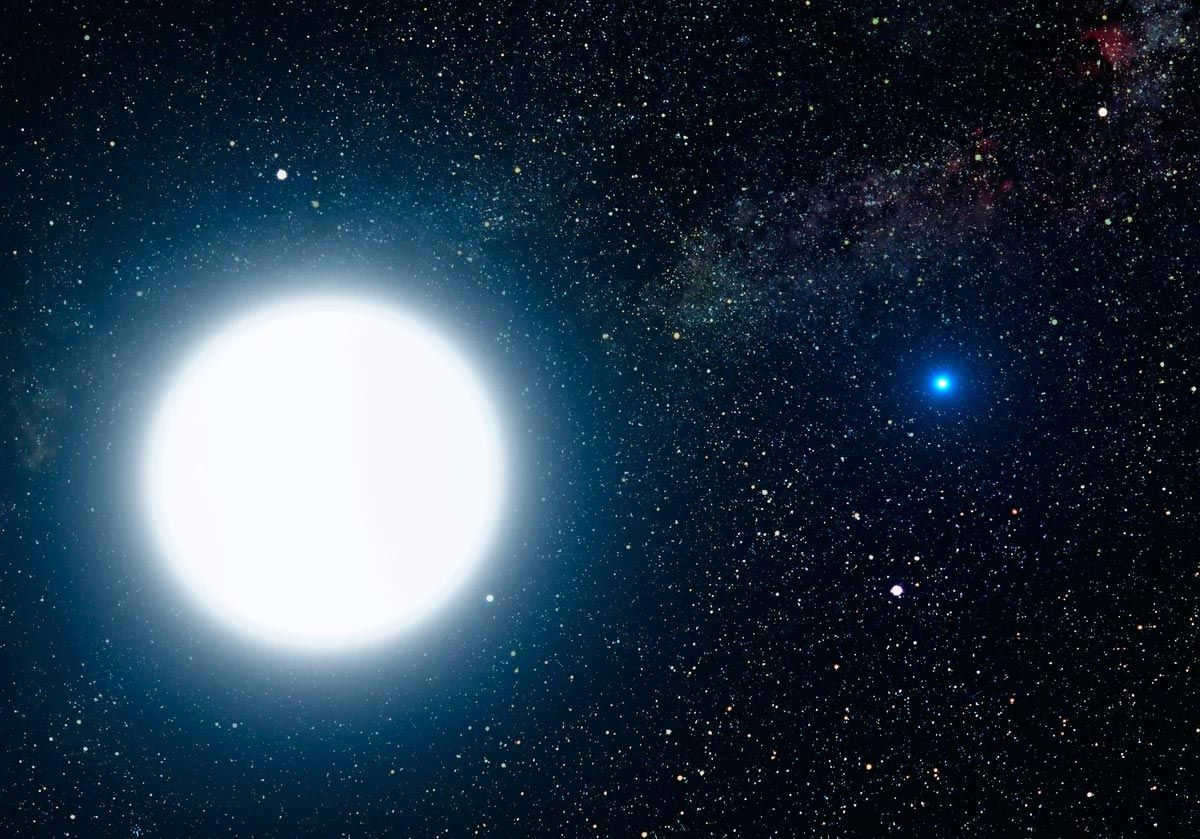
Comparing the sizes of Sirius A and Sirius B – currently, Sirius B cannot be seen with the naked eye from Earth. However, it is possible that this was different about 2 thousand years ago.
There is similar evidence supporting this evolutionary theory: a helium star has a highly condensed core, and if the star’s mass is larger than 2-3 solar masses, it sheds its outer layers. The remaining core undergoes catastrophic compression, resulting in immense density and can exist in the form of a black hole, neutron star, or white dwarf. The latter occurs if the remaining mass is small, approximately 1.0-1.5 solar masses or even less.
It is evident from the aforementioned information that a white dwarf always has a significantly older age compared to a regular white star. However, we are firmly convinced that in a binary system, both stars were formed simultaneously. Consequently, one of them, specifically the white dwarf, underwent its lifespan at a faster pace than the other, resulting in premature aging. This phenomenon is feasible for a star with a considerably large mass.
In the Sirius system, Sirius B possesses a lower mass. Hence, in order to comprehend the current structure of this system, it is imperative to acknowledge that Sirius B had a higher mass in the past but has since shed a significant portion of its original matter.
How did this occur? In the event of rapid matter shedding, a supernova star will erupt, causing the star’s brightness to increase by a factor of 10-100 million, and then gradually diminish over a period of ten years or more. However, it is possible to envision a much more serene process, wherein the outer parts of a star, which appear hazy in space, are released due to radiation emanating from within the star, resulting in the formation of a planetary nebula. These nebulae’s cores are extremely hot (reaching temperatures of 100-200 thousand degrees) and consist of small stars known as white dwarfs.
There is also a third type of evolution that is unique to double systems. It is possible to envision the following sequence of events: Initially, Sirius B, which was more massive, progressed ahead of its companion Sirius A in its development. It expanded and turned into a red giant, with its outer regions coming so close to Sirius A that they started transferring mass to it. This process increased the mass of Sirius A while weakening Sirius B in the process.
Both of these theories are able to provide an explanation for the phenomenon known as the “red Sirius”, however, they both encounter a common obstacle: the process of a star transitioning from a red giant to a white dwarf takes millions of years, whereas we only have a span of eight centuries – from the 2nd to the 10th century – to account for.
Undoubtedly, the commencement of the procedure might have transpired well in advance of the second century, and by the time the second century arrived, the Sirius system had already entered a phase that was nearing its ultimate form – a stage during which it still exhibited a red or reddish hue. For instance, the system’s overall radiance was comprised of an equal combination of the pure white light emitted by Sirius A and the red light emitted by Sirius B. This occurred a significant duration in the past. A substantial duration – when viewed from a human standpoint, and in the context of stellar evolution, a millennium is considered a relatively brief span of time. Nevertheless, if we were to consider the possibility that 18 centuries ago, there was an ejection of matter emanating from the then-massive Sirius B (a phenomenon that has been observed in numerous colossal stars), we must ponder the extent to which this process may have unfolded.
Is it possible that Sirius B underwent a supernova explosion?
According to observations of planetary nebulae, there should be a gas nebula located within an angular distance of up to 1° around Sirius B, or simply put, around the Sirius system. However, the presence of the extremely bright Sirius A may have hindered our ability to detect it. Sirius A’s low temperature does not generate enough radiation to stimulate the glow of the nebula.
Although Sirius B is hotter, its low luminosity limits its ability to excite anything beyond the closest parts of the nebula. Additionally, its brightness is overshadowed by its luminous neighbor. Furthermore, it is unclear if there are any remaining close sections of the nebula, as the outflow of matter has ceased long ago. Consequently, our best hope of detecting the nebula lies in performing extraatmospheric observations in the distant ultraviolet region.
Thus, the gradual retreat of a notable fraction of its mass Sirius B does not contradict the observations, but it is also not corroborated by them. Additionally, we are not exempt from uncertainties regarding the possibility of matter transfer occurring over multiple centuries?
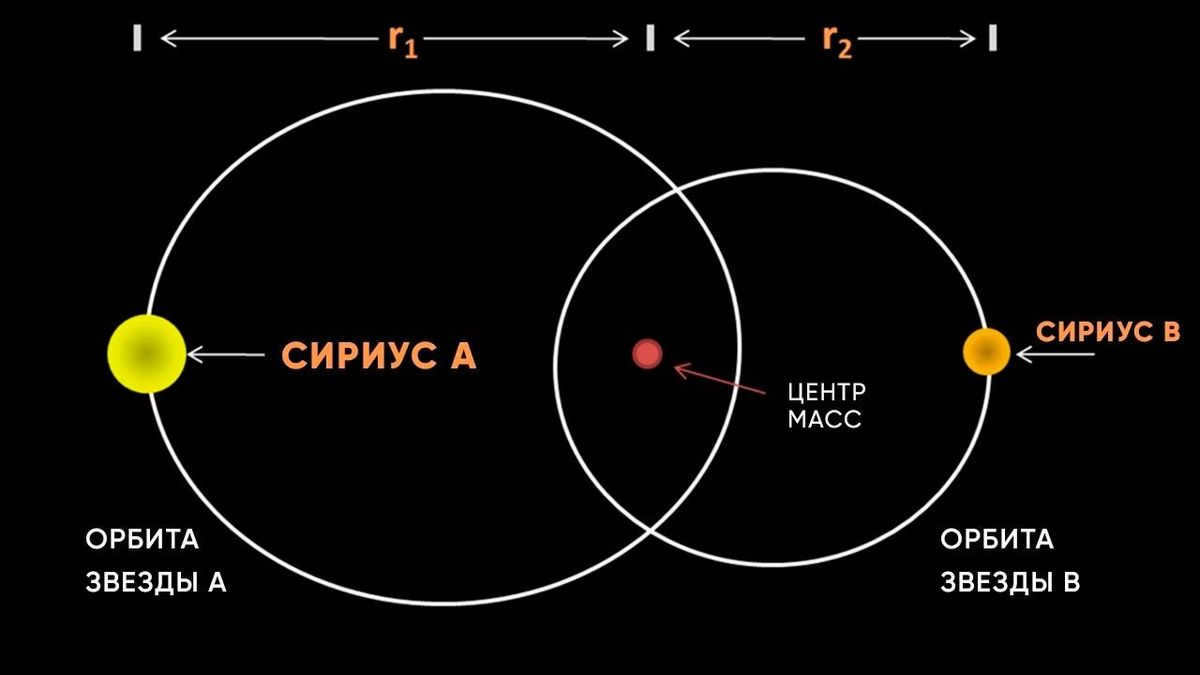
The revolution of the stars in the Sirius system around a shared focal point
Let’s revisit the initial evolutionary model. Assuming that Sirius B underwent a supernova explosion 1,500 years ago, the explosion would have caused a significant increase in the eccentricity of its orbit, which is currently at a high value of 0.58. Taking this into account, along with the present orbital period of the Sirius system and its peculiar motion in space, we can deduce the primary characteristics of the system prior to the explosion. Calculations indicate that the initial mass of Sirius B was 2.9 times that of the Sun. Together with its companion star, it orbited a shared center of mass in a 26 million km orbit with a 12-day period.
The period from the 4th to the 10th centuries in Europe witnessed a significant decline in all fields of science, or rather, the absence of any scientific progress. Surprisingly, even in the 11th century, European sources made no mention of the notable Supernova 1054, which, interestingly, was recorded by the Arabs, Chinese, and Japanese! It is true that during the 6th to 8th centuries, Arab culture had not yet emerged, and it was only in the 7th century that Arab conquerors in Egypt brought about the destruction of the Alexandrian library. However, even in the absence of Arab culture, the Japanese and Chinese civilizations still thrived. Nevertheless, their chronicles do not offer any noteworthy information for us. Could it be that the Supernova occurred before their recorded history or was it simply a fleeting event?
It is true that chroniclers often made note of the appearance of the “guest star”. However, they may have overlooked the increase in brightness of the brightest star in the sky. If the brightness of Sirius, for example, increased by 4-5 magnitudes, it may not have been mentioned in the ancient chronicles. It should be considered that this flash was not like a “real” supernova, but more like a “semi-supernova”.
In modern astronomy, there are several variations of starbursts that raise suspicions as to whether this is a non-standard, non-canonical phenomenon of a supernova that is stretched out over many years or centuries.
We have already designated a star as Kylia. In the 17th century, it was recorded as a star of magnitude 3-4, in the 18th century even 2nd, in the early 19th century 4th, and by the mid-19th century, it could rival Sirius and Canopus in brightness, reaching a magnitude of -1! By the end of the century, it had weakened to almost 8th magnitude, and now it is 2-3 times brighter. The opposite process of slow but steady increase in luminosity by a factor of 40-50 over the last 80 years is happening in the star V Arrow – This star is expected to become the brightest star in the sky by the end of the 21st century! It’s true: “in the heavens, anything is possible,” as Vogel said!
Recycling for sites starcatalog.ru article by Prof. D. Y. Martynov, “Red Sirius” from the journal “Earth and Universe” No. 1 for 1976.
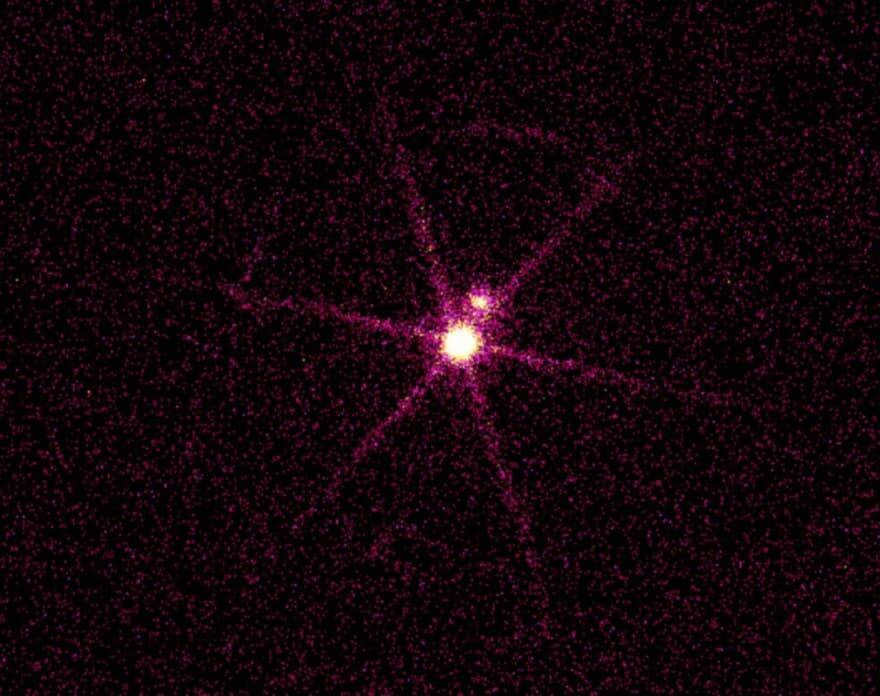
Introduction by A. Koltypin. Previous articles have demonstrated the link between Sirius and the development of ancient civilizations on Earth, as well as the potential control exerted by Sirius over Earth throughout history. This article focuses on the physical attributes of Sirius.
Sirius (Alpha Big Dog) is the most luminous star in the celestial sphere. It is situated 8.60 light-years away from our planet and resides within the constellation of Canis Major. While not the physically brightest star, its proximity to us gives it the appearance of being the brightest. Additionally, it is slowly approaching our solar system, gradually increasing in luminosity. This trend will continue for the next 60,000 years, after which it will reverse. Sirius will retain its brilliance for another 210,000 years.
The brightness of Ho is twice as bright as Canopus in the constellation of Kiel, reaching -1.46. However, it is actually inferior in brightness compared to Canopus and Rigel, which are located further away.
Sirius, also known as the Star of the Dog, derives its name from the Latin word for “to shine”.
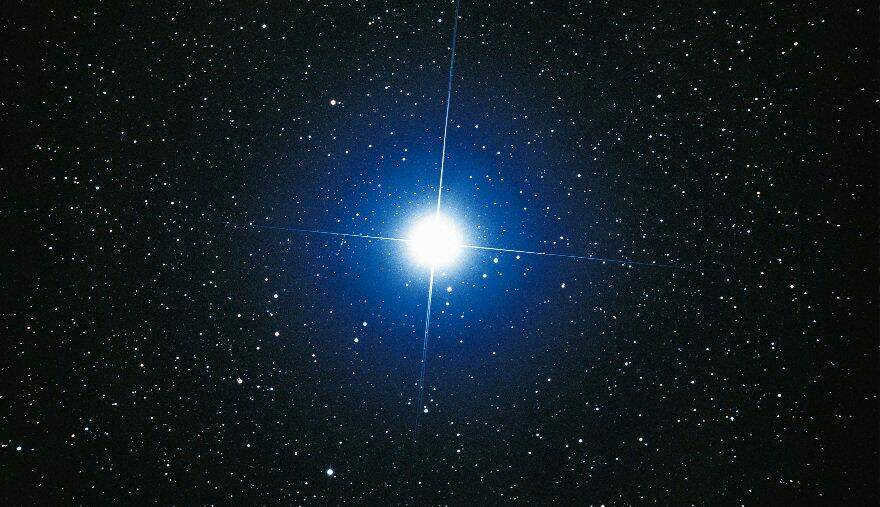
In ancient times, the rising of the star indicated the emergence of the Nile from its banks, while in Greece it marked the beginning of summer (from July to August 11). The heliacal rising occurs when the star is first seen above the eastern horizon before dawn.
Alpha Big Dog may appear as a single star, but in reality, it is a double star system consisting of the white main-sequence star (A1V) Sirius A and the white dwarf (DA2) Sirius B. These two stars have an orbital period of 50.1 years and their average distance is 20 times greater than the distance between Earth and the Sun. The angular separation between them is Z-11 angular seconds.

An X-ray image of the Sirius system, which is located 8.6 light-years away, is shown here. This image reveals two distinct sources, with the brighter one being Sirius B. Sirius B is a white dwarf that has been heated to a scorching temperature of 25000°C. The second source of light in this image is Sirius A, which has a mass that is twice that of our Sun. Interestingly, if you were to observe Sirius A using optical instruments, it would appear to be the brightest star in the sky, despite the fact that Sirius B emits 10000 times more light. The close proximity of these two stars made it difficult to detect the presence of the dwarf until 1862, when Alvan Clarke spotted it while testing the world’s most advanced telescope.
Every 50 years, there is a unique event known as the maximum convergence of the two Siriuses. During this convergence, the two stars can only be distinguished using a 12-inch telescope and under favorable conditions. It is during this convergence period that powerful magnetic storms form between the two stars, causing an acceleration in their rotation.
Sirius A is roughly twice as massive as the Sun and shines 25 times brighter. Its temperature reaches 9940 K. Sirius B is approximately 10,000 times brighter, but it is detectable in the X-ray spectrum. This star revolves around its companion in an elliptical orbit. and possesses a temperature of 25200 K.
Sirius A is classified as an Am star, indicating that it contains elements heavier than helium, such as iron (Z16% of the solar atmosphere).
This stellar system is estimated to be 200 to 300 million years old. Initially, it consisted of two luminous stars, with Sirius B boasting a mass five times that of the Sun. However, through the process of stellar evolution, it transitioned into a red giant and eventually became a white dwarf 120 million years ago.
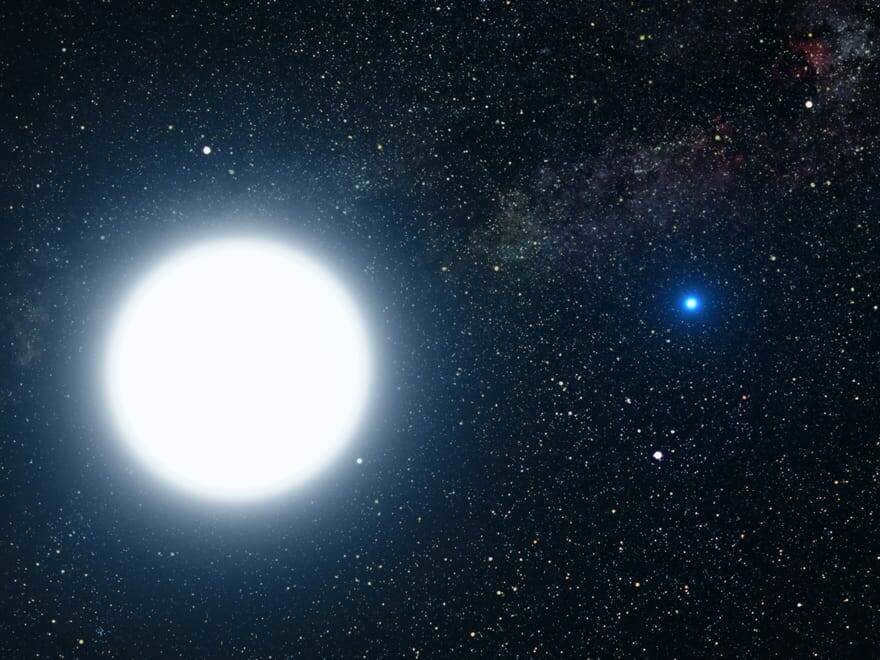
With a diameter of 12,000 kilometers, Sirius B is almost in alignment with the Sun (0.98), making it one of the most massive dwarf stars. This binary companion was first detected by Friedrich Bessel and later observed in 1862 by Alvan Clarke using the largest lens available at that time.
It is possible that the system contains a third large component, although this has not been confirmed. If it does exist, this component would have a mass of only 0.06 times that of the Sun and would complete an orbit every 6 years.
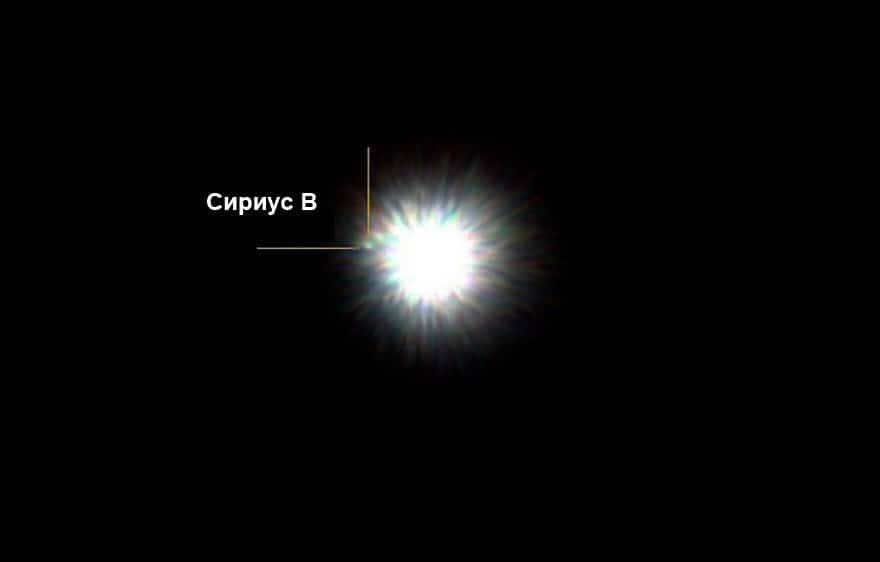
The discovery that Sirius B was a white star was made by Walter Adams. He utilized a 60-inch reflector located at the Mount Wilson Observatory to observe the stellar spectrum. Subsequently, it was determined that we had indeed been observing a white dwarf. The star’s diameter and mass were not determined until 2005, when the Hubble telescope provided assistance.
Interesting Information
Historical documents from the 7th century reveal that Sirius was already known during that time. The renowned poet Hesiod even made a reference to this celestial body in his literary work “Works and Days”.
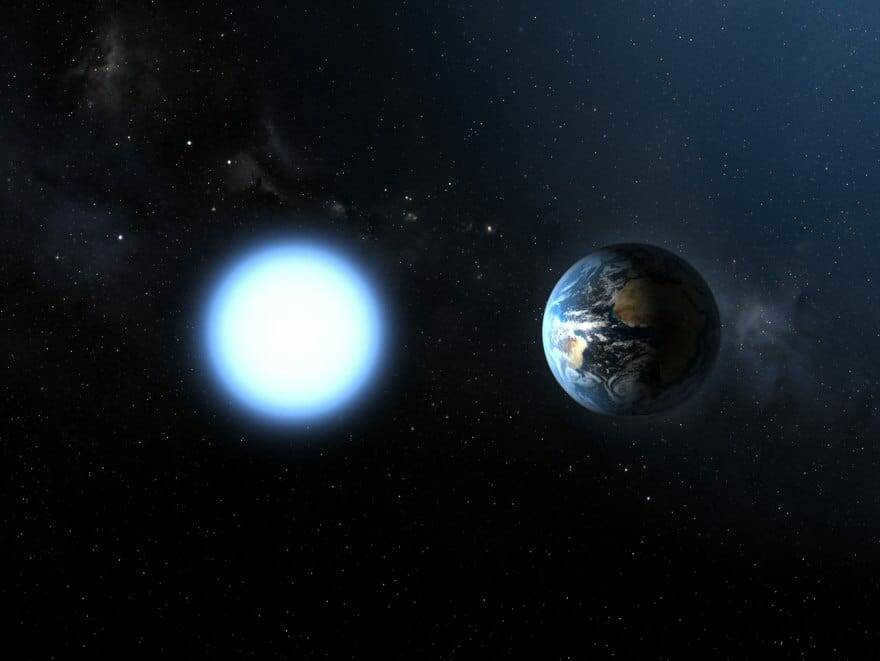
Comparison between Sirius B and Earth
Sirius has over 50 designations. In astrolabes and Western Europe, the star was known as Alkhabor. In Scandinavia, it is referred to as Loki’s torch. Sirius is only surpassed in brightness by the Moon, Venus, Jupiter, and occasionally Mercury and Mars.
Sirius became a significant star for Edmund Halley, as it gave him the concept of proper motion. In 1718, he compared contemporary data with the information in Ptolemy’s Almagest and realized that the stars had shifted positions over a span of 1800 years.
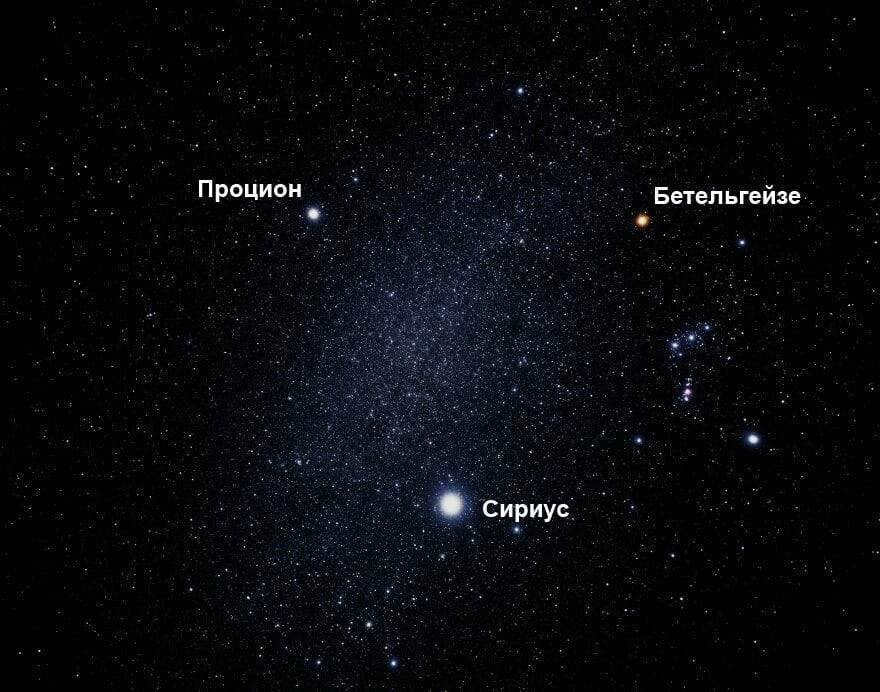
The Winter Triangle consists of three stars: Procyon located at the top left, Betelgeuse at the top right, and Sirius at the base.
When combined with Procyon and Betelgeuse, Sirius forms the Winter Triangle asterism. Voyager 2 was launched in 1977 and has already traveled past the outer planets. In 296,000 years, it will be approximately 4.Z light-years away from Sirius.
At one time, Sirius was classified as a member of the Big Dipper moving group. This classification was made by Einar Hertzsprun in 1909. However, doubts arose between 200Z and 2005 because stars within the group should be around 500 million years old, whereas Sirius is much younger.
Currently, Sirius is part of the Sirius Superscope, which also includes Beta Ascendant, Alpha Veronica, Beta Chalice, Beta Eridanus, and Beta Serpent.
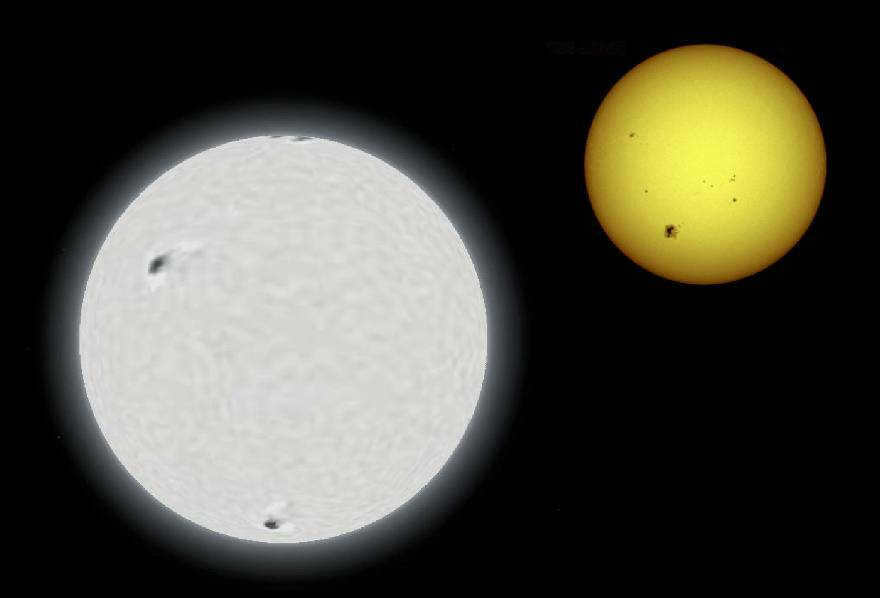
Comparison between Sirius A and the Sun
In 1959, P. Hanbury, B and P. Twiss successfully determined the diameter of Sirius A. The first spectrum of Sirius B was obtained in 1920, while the first satellite photograph was taken in 1970.
The star’s color has been a subject of controversy for many years, as ancient observers described it as red. Ptolemy, for instance, believed this in 150 A.D. Seneca supported his view. However, there were scientists who argued that it appeared blue or white. It is likely that these observations were influenced by the star’s position relative to the horizon, as the Earth’s atmosphere can alter the perceived color.
Many people mistook the periodic flickering of the star for a UFO, but this can be attributed to the fact that its light has to penetrate the Earth’s atmosphere, where there are variations in temperature and density.
The role of the star Sirius in myths and culture
In ancient Egyptian mythology, Sirius was known as Sopdet, symbolized by a hieroglyph of a star inside a triangle. The Egyptians even developed a calendar based on the star’s rise. Its appearance marked the beginning of a new year, and a celebration was held in its honor. When Sirius disappeared before sunrise, it signaled the flooding of the Nile River. This event typically occurred before the summer solstice.
It was believed that the star was not present for a period of 70 days, during which it was thought that Isis and Osiris resided in the underworld. The Egyptians also observed that the heliacal ascension occurred approximately every Z65.25 days. They regarded Sirius as the gateway to the afterlife and refrained from burying the deceased during the 70-day interval when the star vanished from the sky. Some theories propose that the construction of the Giza pyramid was meticulously aligned with the positions of Sirius and the three stars forming Orion’s belt.
The Greeks observed that the appearance of the star signaled the arrival of a hot season. Numerous texts describe it as “burning”. Some individuals even offered sacrifices to it and considered it an auspicious omen. Conversely, if the star appeared hazy and feeble, it was believed to bring death and epidemics.
The Romans observed her ascent on April 25th and made offerings of dogs and sheep. It is interesting to note that the association with canines is present in numerous cultures. Conversely, the Chinese regarded her as the star of the “celestial wolf”. The Polynesians referred to her as the “great bird” Manu and relied on her as a guide. For the Maori, her appearance signaled the onset of winter, while for the Hawaiians, she held the title of Queen of Heaven.
In India, she was known as Swana, the loyal dog of Prince Yudhisthir. Together, they embarked on a quest to find the celestial gateway. However, when they finally discovered it, the dog hesitated to enter. In a display of unwavering loyalty, the prince declined entry into heaven without his faithful companion. Impressed by their devotion, the Lord granted them both admission, testing their fidelity.
The position of the star
Sirius is visible from any location south of 7Z°N. However, if you are further north, it will not appear very high above the horizon. Interestingly, Sirius is considered a circumpolar star, which means it never dips below the horizon line.
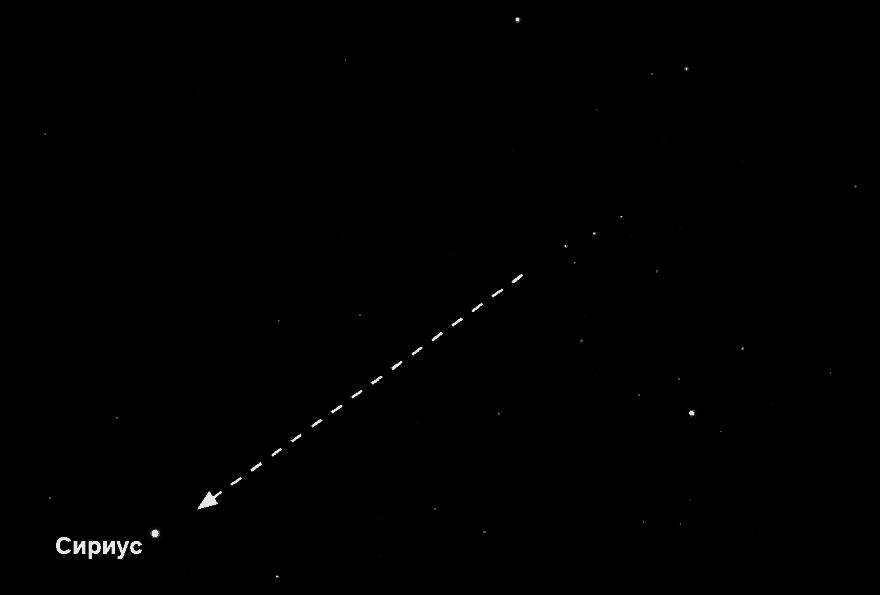
Due to precession, the star known as Alpha in the constellation Canis Major will gradually shift towards the south, and by the year 9000 it will no longer be visible from most locations in northern and central Europe. By 14000, the star Vega will take its place as the polar star.
To locate Sirius, one can use the stars Alnilam, Alnitak, and Mintaka, which form the famous belt of the constellation Orion. For observers in northern latitudes, Sirius can be seen in the southeastern, southern, and southwestern sky during the winter months. In the late summer, it can be found in the east just before dawn.
– Sirius is the brightest star in the constellation Canis Major, also known as the Big Dog.
– Coordinates: 06h 45m 08.917Zc (right ascension), -16° 42′ 58.017″ (declination).
– Distance: 8.6 light-years.





